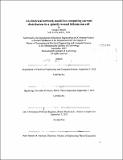An electrical network model for computing current distribution in a spirally wound lithium ion cell
Author(s)
Patnaik, Somani
DownloadFull printable version (7.487Mb)
Other Contributors
Massachusetts Institute of Technology. Department of Electrical Engineering and Computer Science.
Advisor
Jing Kong and Jake Christensen.
Terms of use
Metadata
Show full item recordAbstract
Lithium ion batteries are the most viable option for electric vehicles but they still have significant limitations. Safety of these batteries is one of the concerns that need to be addressed when they are used in mainstream vehicles, because of heating issues that may lead to thermal runaway. This work aims at supplementing the existing electrochemical heat distribution model of a spirally wound lithium ion battery with an electrical network that can model the heat losses due to electric resistances of the current collectors. The developed electrical network model is used to calculate the current and state-of-charge distribution throughout the spiral jelly roll, which can be used to determine electric heat losses. The results obtained from this model can then be used to optimize the shape and dimensions of the current collectors as well as the materials used in them.
Description
Thesis: M. Eng., Massachusetts Institute of Technology, Department of Electrical Engineering and Computer Science, 2012. "September 2012." Page 74 blank. Cataloged from PDF version of thesis. Includes bibliographical references.
Date issued
2012Department
Massachusetts Institute of Technology. Department of Electrical Engineering and Computer SciencePublisher
Massachusetts Institute of Technology
Keywords
Electrical Engineering and Computer Science.